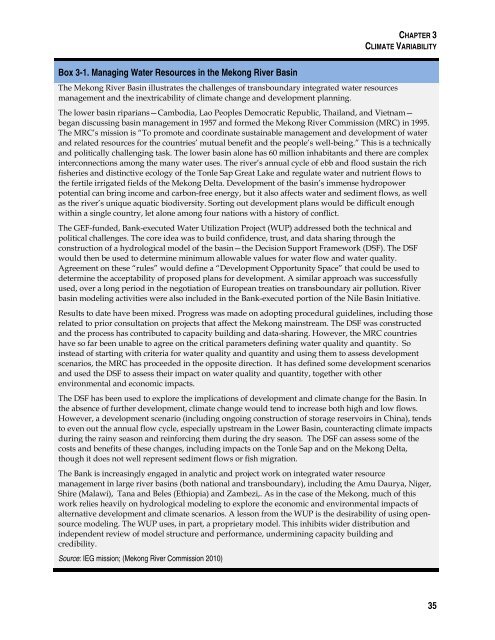Adapting to Climate Change: Assessing the World Bank Group ...
Adapting to Climate Change: Assessing the World Bank Group ...
Adapting to Climate Change: Assessing the World Bank Group ...
You also want an ePaper? Increase the reach of your titles
YUMPU automatically turns print PDFs into web optimized ePapers that Google loves.
CHAPTER 3CLIMATE VARIABILITYBox 3-1. Managing Water Resources in <strong>the</strong> Mekong River BasinThe Mekong River Basin illustrates <strong>the</strong> challenges of transboundary integrated water resourcesmanagement and <strong>the</strong> inextricability of climate change and development planning.The lower basin riparians—Cambodia, Lao Peoples Democratic Republic, Thailand, and Vietnam—began discussing basin management in 1957 and formed <strong>the</strong> Mekong River Commission (MRC) in 1995.The MRC’s mission is “To promote and coordinate sustainable management and development of waterand related resources for <strong>the</strong> countries’ mutual benefit and <strong>the</strong> people’s well-being.” This is a technicallyand politically challenging task. The lower basin alone has 60 million inhabitants and <strong>the</strong>re are complexinterconnections among <strong>the</strong> many water uses. The river’s annual cycle of ebb and flood sustain <strong>the</strong> richfisheries and distinctive ecology of <strong>the</strong> Tonle Sap Great Lake and regulate water and nutrient flows <strong>to</strong><strong>the</strong> fertile irrigated fields of <strong>the</strong> Mekong Delta. Development of <strong>the</strong> basin’s immense hydropowerpotential can bring income and carbon-free energy, but it also affects water and sediment flows, as wellas <strong>the</strong> river’s unique aquatic biodiversity. Sorting out development plans would be difficult enoughwithin a single country, let alone among four nations with a his<strong>to</strong>ry of conflict.The GEF-funded, <strong>Bank</strong>-executed Water Utilization Project (WUP) addressed both <strong>the</strong> technical andpolitical challenges. The core idea was <strong>to</strong> build confidence, trust, and data sharing through <strong>the</strong>construction of a hydrological model of <strong>the</strong> basin—<strong>the</strong> Decision Support Framework (DSF). The DSFwould <strong>the</strong>n be used <strong>to</strong> determine minimum allowable values for water flow and water quality.Agreement on <strong>the</strong>se “rules” would define a “Development Opportunity Space” that could be used <strong>to</strong>determine <strong>the</strong> acceptability of proposed plans for development. A similar approach was successfullyused, over a long period in <strong>the</strong> negotiation of European treaties on transboundary air pollution. Riverbasin modeling activities were also included in <strong>the</strong> <strong>Bank</strong>-executed portion of <strong>the</strong> Nile Basin Initiative.Results <strong>to</strong> date have been mixed. Progress was made on adopting procedural guidelines, including thoserelated <strong>to</strong> prior consultation on projects that affect <strong>the</strong> Mekong mainstream. The DSF was constructedand <strong>the</strong> process has contributed <strong>to</strong> capacity building and data-sharing. However, <strong>the</strong> MRC countrieshave so far been unable <strong>to</strong> agree on <strong>the</strong> critical parameters defining water quality and quantity. Soinstead of starting with criteria for water quality and quantity and using <strong>the</strong>m <strong>to</strong> assess developmentscenarios, <strong>the</strong> MRC has proceeded in <strong>the</strong> opposite direction. It has defined some development scenariosand used <strong>the</strong> DSF <strong>to</strong> assess <strong>the</strong>ir impact on water quality and quantity, <strong>to</strong>ge<strong>the</strong>r with o<strong>the</strong>renvironmental and economic impacts.The DSF has been used <strong>to</strong> explore <strong>the</strong> implications of development and climate change for <strong>the</strong> Basin. In<strong>the</strong> absence of fur<strong>the</strong>r development, climate change would tend <strong>to</strong> increase both high and low flows.However, a development scenario (including ongoing construction of s<strong>to</strong>rage reservoirs in China), tends<strong>to</strong> even out <strong>the</strong> annual flow cycle, especially upstream in <strong>the</strong> Lower Basin, counteracting climate impactsduring <strong>the</strong> rainy season and reinforcing <strong>the</strong>m during <strong>the</strong> dry season. The DSF can assess some of <strong>the</strong>costs and benefits of <strong>the</strong>se changes, including impacts on <strong>the</strong> Tonle Sap and on <strong>the</strong> Mekong Delta,though it does not well represent sediment flows or fish migration.The <strong>Bank</strong> is increasingly engaged in analytic and project work on integrated water resourcemanagement in large river basins (both national and transboundary), including <strong>the</strong> Amu Daurya, Niger,Shire (Malawi), Tana and Beles (Ethiopia) and Zambezi,. As in <strong>the</strong> case of <strong>the</strong> Mekong, much of thiswork relies heavily on hydrological modeling <strong>to</strong> explore <strong>the</strong> economic and environmental impacts ofalternative development and climate scenarios. A lesson from <strong>the</strong> WUP is <strong>the</strong> desirability of using opensourcemodeling. The WUP uses, in part, a proprietary model. This inhibits wider distribution andindependent review of model structure and performance, undermining capacity building andcredibility.Source: IEG mission; (Mekong River Commission 2010)35

















